How Long Does It Take to Transfer 18 Gb of Data
We are reader supported and may receive a commission when you make purchases using the links on our site
11 Best Ways to Transfer, Share or Send Large Files in 2021
Email, social media and messaging apps are great for sending files across the globe, but as files we share increase in size we quickly discover the limitations of familiar methods. In this post, we look at the best ways to transfer, send, or share large files.

Whether you're trying to send a promotional video to a client or a home tape to a family member, transferring large files can be a headache without the right tools.
Trying to send a bunch of video files through an email account is far from ideal. Given that email providers like Google (Gmail) only allow you to attach files up to 25MB, you need an alternative.
Here are the 11 best ways to transfer, send or share large files:
- Upload your files to cloud storage Files.com and Dropbox are examples of cloud storage systems that enable files to be distributed through sending links to the file's location.
- Compress the files Use systems such as 7-Zip, Express Zip, and WinZip to reduce the file size before sending.
- Use a VPN Mask the size of the file and its real destination from restrictions imposed by ISPs.
- USB Flash Drive Move the file physically by carrying it on removable storage.
- FTP Use the straightforward unencrypted file transfer system that is fast and will move large files.
- SFTP Passes files along a secure tunnel and enables file transfers interrupted by dropped connections to be resumed.
- FTPS A secure file transfer system that is protected by TLS, which guards safe browser connection in HTTPS.
- Jumpshare A link-sharing system that includes a free account option.
- Courier a Hard Drive Move a large volume of files safely over long distances.
- Send Anywhere A file storage and link sharing system that can manage files up to 10 GB in size.
- WeTransfer A free file access and distribution system that handles files of up to 2 GB and can be upgraded for a fee to manage files up to 20 GB in size.
How to send large files
1. Upload your files to cloud storage

Uploading files to cloud storage is a great way to transfer large files such as photos and video. Popular cloud service providers like Google Drive, Files.com, Dropbox, and OneDrive offer mountains of online storage. Each of these products is accessible with more than enough space to cover most file types.
These solutions are cost-effective so that you don't have to pay a premium to be able to store and access your files in the cloud. For example, Google Drive is free for your first 15 GB of storage space.
What should you look for in large file transfer systems?
We reviewed the market for transfer software and analyzed the options based on the following criteria:
- The ability to manage the transfer of large files
- A range of secure transfer options
- An easy-to-use interface
- Options for air-gap transfers
- Activity logging
- A free tool or a free assessment period
- A good set of useful tools at a reasonable price that represents value for money
Files.com (FREE TRIAL)
Files.com charges a monthly subscription per user with three plan levels. The Starter plan is charged at $10 (£8.10) per month. Users can try the system for free on a 7-day free trial.
The Files.com system is frequently used by media companies because it is particularly good at transferring large files of up to 5 TB. The cloud service deploys a transfer accelerator to speed up file transfers to the server.

One a large file is resident at Files.com, the user just sends a link to the intended recipient for access on the server rather than transferring the file onward.
Pros:
- Scalable solution, making it ideal for both small businesses and enterprises alike
- Features robots user management, permissions, and access control to support long term use
- Allows users to create links to files that have special rules, such as expiration dates or click tracking
- Can compress large files for faster transfer
- Supports integrations into other cloud-based storage options such as Dropbox, Google Drive, and OneDrive
Cons:
- While the platform is easy to use, some of the more advanced features can take time to learn and implement
Files.com Start a 7-day FREE Trial
Dropbox is another popular choice out of the three because it has a desktop application and mobile application that allows you to upload files no matter what size they are. If you upload these files to the Dropbox website then you'll have to stay below a limit of 50GB.
The user interface on the desktop application is also very user-friendly, all you need to do is right-click the Share button on the file you want to send and then enter the email addresses of the people you want to share the file with.
Pros:
- Allows for files transfers on mobile as well as desktop devices
- Supports automatic synchronization
- Is a scalable subscription-based platform
- Great for collaboration
Cons:
- Could separate personal and work files better in the app
- Could make switching between accounts easier
- Permission management can be difficult to understand and implement at scale
Dropbox is free for less than 2GB of storage space. Though you can also upgrade to the Professional version for $19.99 (£16.19) with up to 2 TB worth of space.
2. Compress the Files
Another tried and tested method of transferring files is to compress them. Compressing the files reduces the amount of space that is needed to store them. The process of creating a zip file is simple on Windows.
All you need to do is create a folder and place all of the files you want to transfer into it. After you've created the folder you can right-click on it and select Send to > Compressed (Zipped folder). The files are ready to be sent.
It is important to note that file compression is ineffective for JPEG and MP3 files because they've already been compressed! To process the files you can use free compression software such as 7-Zip, Express Zip and WinZip.
Pros:
- Gives you more control over which channel you send the files
- Saves time on transferring files and potentially money if planning to store them on a cloud-based system like Google Drive
Cons:
- Is a manual process that requires knowledge of file compression
- Is not automatically applied to files, wasting time for frequent files transfers
- Is not effective for files that are already in compressed formats
- The recipient must understand how to decompress and retrieve the files
3. Use a VPN
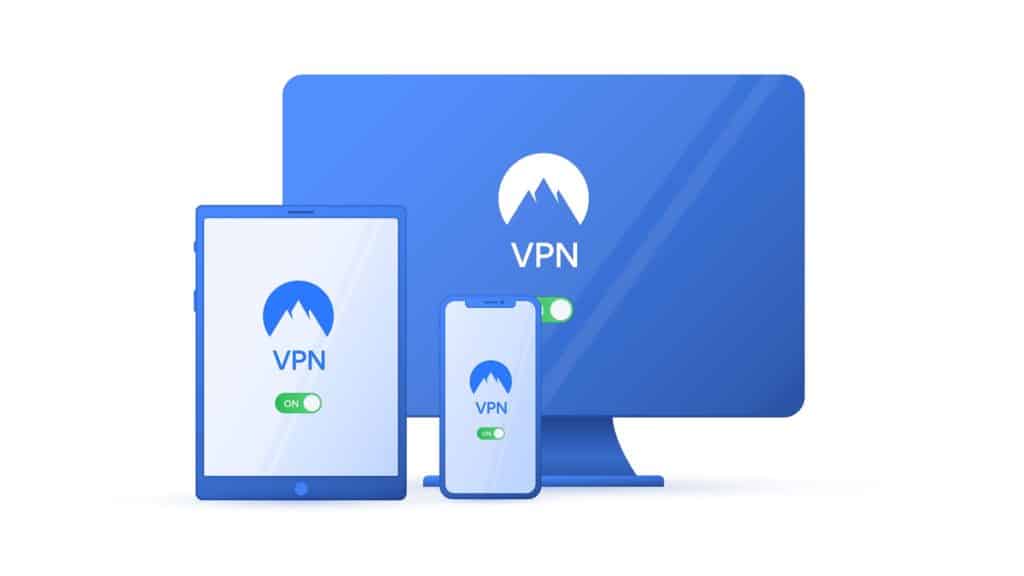
Using a VPN or Virtual Private Network is a useful technique for transferring files because it allows you to avoid broadband traffic management restrictions placed by your internet service provider (ISP). Many ISPs control upload bandwidth to restrict the size of files that you can upload.
A VPN is used to encrypt your traffic and keep your online activities confidential. When using a VPN an ISP can't identify the contents of your web traffic. For file transfers, this means that the ISP can't recognize the size of the files and impose any limits on you.
Sending files through a VPN isn't without its issues. The internet connection will likely slow down substantially and the files won't necessarily arrive intact. So if the quality is a large concern, it is advisable to try an alternative tool.
Pros:
- Allows for private and secure data transfer between two sites
- Circumvents protocol or application-based throttling
- Can be faster than using a public service
Cons:
- Requires technical understanding of how to set up a site to site VPN, or how to install one on your own
- Not viable for one-off transfers, more suited for long term file-trading like EDI partnerships
4. USB flash drive
USB flash drives are an excellent alternative if you need to transfer files to a friend or colleague. USB flash drives range in size from 2 GB to 1 TB giving you more than enough space to upload files even of the densest content. Of course, if you decide to use a USB flash drive you will have to make sure that you don't misplace it!
With a flash drive transferring files is extremely easy because all you need to do is insert the drive into your computer's USB ports. Once the computer recognizes the drive you can drag-and-drop the files you want into it.
After that, you can eject the draft and take it to another device or individual. While there's a little more legwork required with this method, it's very easy to do. If you want simplicity and reliability then this one is a good choice.
Pros:
- Possibly the simplest form of file transfer
- Very easy to do
- Recipient can easily retrieve the files
Cons:
- Not secure unless the drive is properly encrypted
- Data is lost if the drive is lost or corrupted
- 'Sneakernetting' requires you to physically send the USB drive
- Not ideal for time-sensitive file transfers
- Not ideal for site backups or extremely large file transfers
- Not a viable option for continuous backups
5. FTP
FTP or File transfer protocol is an old school way to transfer files. FTP is a TCP/IP protocol that transfers files between FTP servers and clients. FTP was designed specifically for transferring large files. All you need to do to start using the protocol is an FTP client.
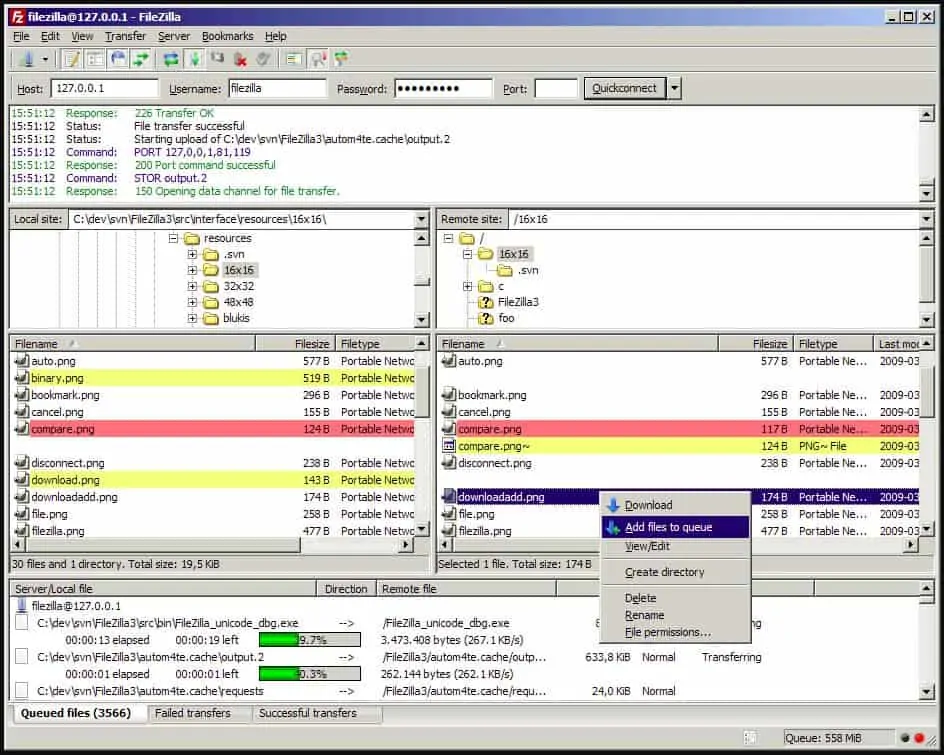
The good thing about FTP is that what it lacks in security it makes up for with its file management capabilities. There's no restriction on the size of single transfers, you can queue transfers, schedule future transfers, and send multiple files at once. The advantages of FTP make it one of the more efficient ways to send files back and forth.
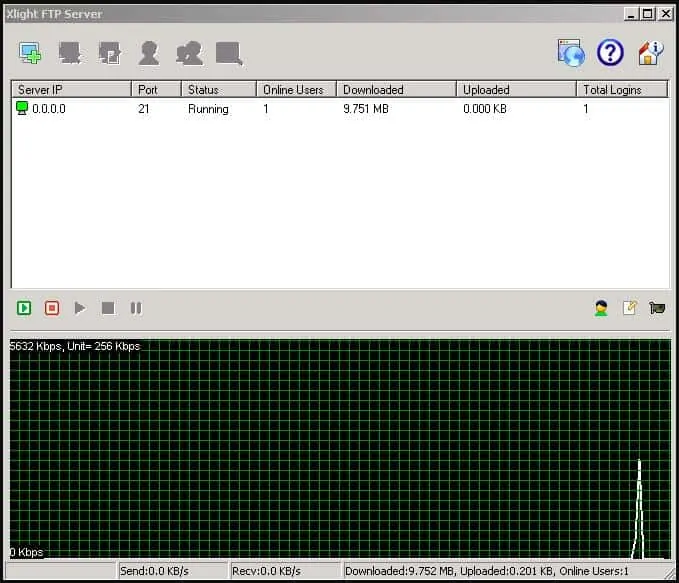
There are many free FTP clients online like FileZilla and Xlight. The only problem with FTP is that it is not secure. Usernames and passwords are transferred in plain text so an attacker can read the contents of files. To protect against attackers use FTP for non-confidential data.
Pros:
- Easy to use, even for users who aren't as tech-savvy
- No restrictions on file type, size, or number of transfers
- Great option for trading files with a partner you know and trust
Cons:
- Inherently isn't as secure
- Can be hacked if misconfigured or has weak credentials
- System will not work if either site is having server or internet issues
- Requires technical setup that requires IT experience
Related Post: How to Resolve common FileZilla Errors
6. SFTP
Secure File Transfer Protocol or SFTP is the secure variant of FTP. The protocol enables the user to transfer files through Secure Shell (SSH). SSH serves to prevent unauthorized users from viewing passwords and other information through encryption while files are in transit.
To transfer a file the server must authenticate the client user and verify the channel is secure. The inbuilt security features of SFTP make it ideal for sending sensitive data in an enterprise environment.
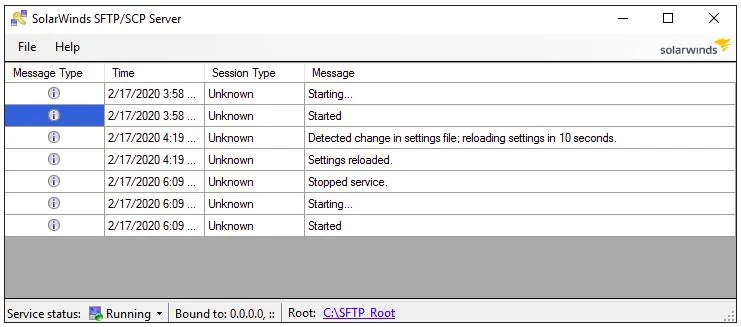
Most FTP servers include SFTP transfers by default. Reliable free SFTP servers include SolarWinds SFTP/ SCP Server, FileZilla, and Syncplify.me Server. SFTP is also advantageous when compared to FTPS because it doesn't require lots of open ports to function (open ports are potential entry points into your network).
SolarWinds SFTP/SCP Server Download 100% FREE Tool
However, SFTP is a little less convenient than some other measures on this list because you have to install an SFTP server and configure it. So if you want simplicity you're better off with a cloud storage solution. In addition, if regulatory compliance is a concern then the lack of user activity logs can cause problems.
Pros:
- A more secure option than FTP, helps protect data in transit better
- Doesn't utilize a large number of open ports
- Can move files using CLI
Cons:
- Can be hacked if misconfigured or has weak credentials
- System will not work if either site is having server or internet issues
- Requires technical setup that requires IT experience
7. FTPS
File Transfer Protocol Secure or FTPS is another secure version of FTP. FTPS is secured over Secure Sockets Layer or SSL (also known as TLS) which encrypts connections. With this protocol, file transfers can be authenticated through passwords, client certificates, and server certificates. FTPS authenticates connections with a user ID and password or certificate and verifies the certificate of the server you're connecting to.
The main advantage of FTPS is that its encryption makes it a safe way to send confidential information. It also has the strength of being compliant with most regulatory frameworks. FTPS transfers are PCI DSS, SOX, HIPAA, and HITECH compliant. It is important to note that FTPS isn't without its vulnerabilities.
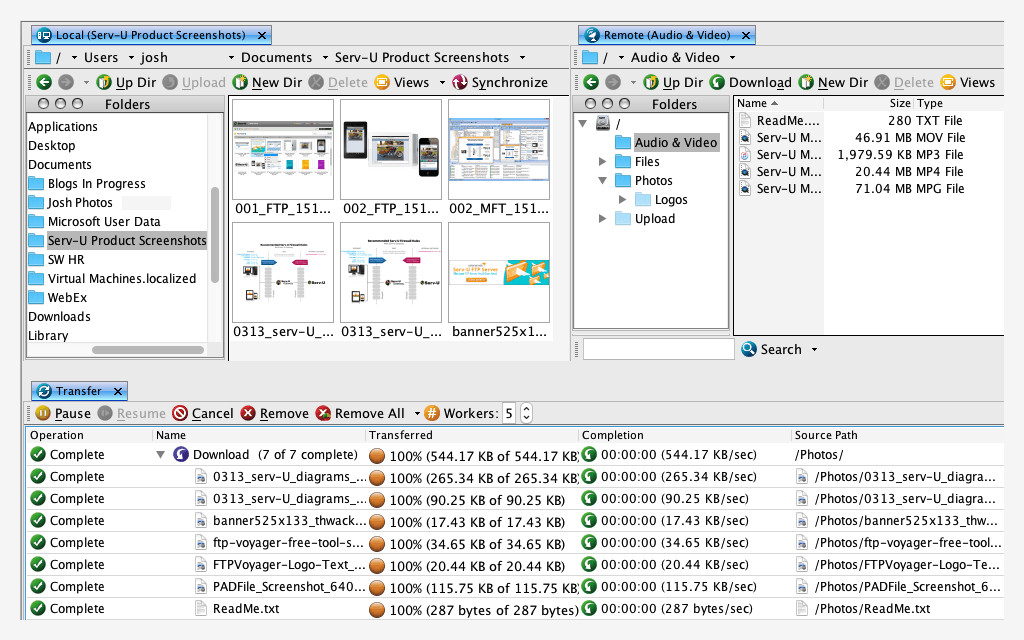
Every time a file transfer is made a port will be opened, which could be an entry point for an attacker. As a consequence, many firewalls make it difficult to use FTPS connections. Not all FTP servers support FTPS but there are many products that do. Syncplify.me, and FileZilla all support FTPS.
8. Jumpshare

There are many free and paid online services that enable you to upload large files and Jumpshare is one of the most popular. Jumpshare allows you to send up to 250 MB of files for free and record them as shareable links. Whoever has the link can then access the file content.
If you compare this with the 25 MB limit of most email services, there is a substantial difference. These tools are also very user-friendly. For example, in Jumpshare you can drag-and-drop the files that you want to share to the menu bar icon. Then a link will be copied to your clipboard.
Using Jumpshare is a good idea if you want the convenience of transferring files online without the need to use any more technical "workarounds." All you need to do to begin is sign up online on the vendor website.
Pros:
- Easy to use interface uses a drag and drop feature
- Can send files as simple downloadable links
- No technical setup
Cons:
- Can only move 25 MB of files for free
- Requires email login
- Not the best option for long term large file transfers such as backups, replications, or EDI systems
9. Courier a Hard Drive
If you have lots of large files to send then filling up a hard drive and sending it off with a courier is an effective way to transfer files. Physically sending a large volume of files via a courier is often much faster than attempting to upload those files through a broadband connection.
Shipping hard drives can raise some concerns in terms of damage and theft. If you make the decision to send your hard drive via a courier you have to make sure that it is packaged correctly so that it won't get damaged in transit.
Pros:
- About as easy as ordering a pizza
- Very easy to do
- Recipient can easily retrieve the files
Cons:
- Drive can get damaged in shipping, losing the data
- Data can get potentially stolen if lost, unless encrypted
- Shipping a large amount of information on multiple drives could cost prohibitive
- Not a good long term solution for regular data transfers
10. Send Anywhere

Send Anywhere is a file-sharing application that allows you to send files with a 6-digit key from your device to any destination you desire. You can create a link to access files so that other individuals can access your shared files in any location. Files also have an expiration time so that the files will become unavailable after a specific time period. Send Anywhere has a 10 GB file size limit. The application supports a range of operating systems including Windows, Mac OS, Linux, Android, iOS, Amazon Kindle, and Outlook Add-In.
If you require more firepower, you can purchase Send Anywhere PLUS, which will give you a server to work with. Send Anywhere PLUS is faster with a 100 MB/s transfer speed and uploads at up to 50 GB at once. The paid version is also very affordable at $5.99 (£4.85) per month.
Pros:
- Supports up to 10 GB of files per send
- Uses six-digit code to access the files securely
- Cross-platform with Windows, Mac, and Linux
- File access available on iOS and Android mobile app
Cons:
- Not the best option for EDI transactions or files that must remain in compliance
- Not a viable solution for site replication or server backups
11. WeTransfer
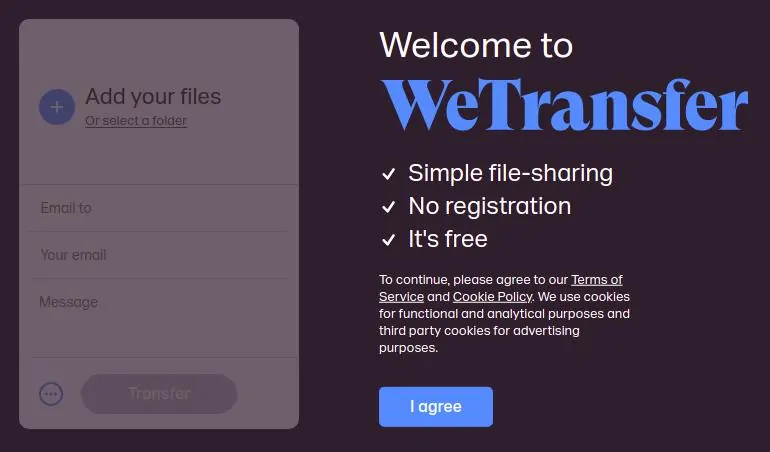
Finally, we have WeTransfer. WeTransfer is a free online file-sharing service that requires no registration. All you need to do to use it is go onto the website, add your file, enter the destination email address, your email address, and a message. The free version enables you to transfer up to 2GB worth of files.
You can also upgrade to WeTransfer Plus which supports 20 GB of file transfers at once and up to 100Gb storage total for $12 (£9.72) a month. You can also protect your files with a password and customize the emails you send. The large file transfer limit should cover most enterprise users sufficiently.
The fact that you don't need to signup or download anything makes WeTransfer a top pick if you want to transfer a file. So if you want to share files without any hassle then you can't go wrong here.
Pros:
- Free version generously offers 2GB of file transfers
- Great for one-off files that are too big for email systems
- Doesn't require a download
- Doesn't require the recipient to sign up or install anything
Cons:
- Not the best option for EDI transactions or files that must remain in compliance
- Not a viable solution for site replication or server backups
No matter how many large files you need to send there is a medium out there to help. The file transfer service you use can be as complicated or as simple as you want. Don't get trapped by file limits imposed by your email provider! Pick a storage solution that can accommodate the bandwidth of files you need to transfer (and a VPN if your ISP is capping your uploads).
If you're more old school then purchasing a flash drive will give you an efficient means to transfer your data. But if you want something you can access from anywhere, then a cloud storage provider like Google Drive or Dropbox is probably a better fit.
If you're more technically minded and want to manage a high volume of file transfers then downloading an FTP server might be worth it for low priority files (make sure to use FTPS or SFTP for secure file transfers if you go this route!).
How do I send large files from my phone?
There is no technical difference between sending files from a phone or tablet as there is from a computer. The biggest issue with file transfers from a phone arises from the individual's data plan. If it is metered, you could end up paying a lot for an extra data allocation. If this is the case, send the file while connected to a WiFi system and turn off data temporarily.
How can I send a large file with a slow connection?
One of the biggest risks with slow connections is that the longer a session lasts, the higher the possibility of a dropped link. Use a data transfer app that will pause and resume a transfer in the case of a lost connection. Some transfer utilities will split a file up and send segments concurrently. However, if you have restricted bandwidth, that won't solve the problem.
Can hackers attack my cloud storage?
There have been a number of very well-publicized hacks of cloud storage in the past. However, many cloud storage providers have tightened up their account access procedures with the introduction of the-factor authentication (2FA). This involves a challenge question sent to your phone and makes it impossible for a faraway hacker to get into your account even with the password.
How do I bypass Google Drive virus scan warning about large files?
Google Drive scans files before downloading them if you request to download or send them. It can only scan a file of up to 25 MB; anything larger gets a warning that the file can't be scanned. However, the file will be downloaded anyway. To completely avoid this message, split the file up. If you want to send the file to someone, send them a link instead so they can view it online.
How Long Does It Take to Transfer 18 Gb of Data
Source: https://www.comparitech.com/net-admin/best-ways-to-transfer-large-files/
0 Response to "How Long Does It Take to Transfer 18 Gb of Data"
Post a Comment